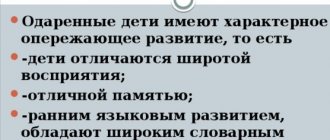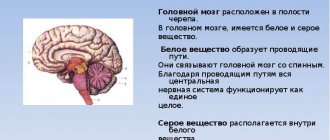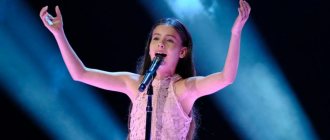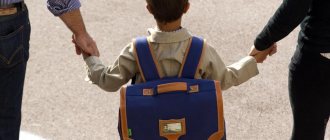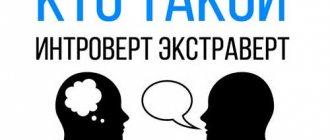The documents of the national educational initiative “Our New School” note that a support system for talented children should be created. Simultaneously with the implementation of the general education standard, an extensive system of searching for and supporting talented children, as well as accompanying them throughout the entire period of personal development, must be built.
It will be necessary to create both a special support system for mature, talented schoolchildren, and a general environment for the manifestation and development of the abilities of each child, stimulation and identification of the achievements of gifted children. In addition, it is indicated that within the framework of the system of supporting talented children, it is advisable to support a creative environment and provide the opportunity for self-realization for students of each secondary school. To do this, it is necessary to expand the system of Olympiads and competitions for schoolchildren, the practice of additional education, various kinds of student conferences and seminars, and work out mechanisms for taking into account individual achievements of students (student portfolios) during admission to universities.
Who is a gifted child?
A gifted child is a child who stands out for his bright, obvious, sometimes outstanding achievements (or has internal prerequisites for such achievements) in a particular activity.
Today, most psychologists recognize that the level, qualitative originality and nature of the development of giftedness are always the result of a complex interaction between heredity (natural inclinations) and the social environment. At the same time, the role of psychological mechanisms of personality self-development cannot be ignored.
Some psychologists believe that gifted children in a regular school do not receive proper understanding from adults and peers, and are subject to ridicule and almost bullying.
Among modern concepts of giftedness, the theory of the famous American specialist in the field of studying gifted children, Joseph Renzulli, can be called the most popular. In his opinion, giftedness is a complex result of the superposition of 3 factors:
- above average abilities
- creativity,
- involvement in the task.
Is it good to be gifted?
Of course, a child’s development cannot be limited only to the family. But not every type of giftedness is related to school and finds conditions for development there. For example, the so-called social (leadership) talent, for obvious reasons, is not always encouraged by teachers and even parents. They simply don't know what to do with such children.
Early manifested talent in the arts (musical, artistic, acting) or in sports probably has no direct relation to school either. Often such a child does not feel very comfortable at school: due to constant employment, he communicates less with classmates, and often misses classes due to concerts or competitions. Such children often have emotional problems due to high competition with other children in their “specialty.”
Giftedness at school
Other types of giftedness are important for success in secondary school. There are children with a pronounced ability to learn, to assimilate the educational material offered to them. Moreover, they demonstrate this ability regardless of the difficulty of the subject and their own interests. This is the so-called academic giftedness . Children with this type of giftedness have a much easier school life, and their successes make their parents happy. And subsequently it is easier for them to get a good specialty and achieve success in their work. It is generally accepted that such children usually do not reach any special heights.
Other schoolchildren are distinguished by special intellectual talent: the ability to think, compare, highlight the main thing, draw independent conclusions, make predictions, etc. But, unfortunately, the success of such children most often depends on their attitude, interest in the subject and its teacher. They may study unevenly (either “five” or “two”): brilliantly in one subject and “so-so” in another.
A special type of giftedness is creative talent . This does not only mean abilities in visual, musical or literary activities. Creative talent is, first of all, a non-standard perception of the world, originality of thinking, and a rich emotional life.
Methods for developing your own abilities
Methods for developing potential and revealing talent depend on the nature of abilities and inclinations. The issue is resolved on an individual basis.
If the creative component prevails, it makes sense to start practicing art in its different variations. Development of musical ear, instilling artistic taste and other techniques.
Special methods for developing intellectual abilities are used. Solving problems, puzzles. Reading and writing short essays on a free or given topic have a good effect. Analysis and retelling of read material with increasing complexity of stimulating texts.
Academic talent develops in the course of, oddly enough, learning. The task is not so much to give specific tasks as to guide and monitor the process, creating the necessary conditions.
What is life like for gifted children at school?
No easier than any other child. At the same time, children with a specific type of giftedness may have different adaptation problems. Perhaps the easiest to adapt to in school are the “academically gifted.” They delight parents and teachers with their successes. They don’t have any special problems communicating with their peers - they are always ready to explain something, help, even “let them copy it off.” And their extracurricular interests usually do not differ from the interests of their classmates.
“Intellectuals” are treated condescendingly at school. They admire their abilities in one area (for example, physics or mathematics) and sometimes forgive complete failure in something else (for example, illiteracy in writing). They often delight the school with their brilliant successes at competitions at various levels. These children are often so absorbed in their intellectual hobbies that they do not feel much need for attention from their classmates. Although they may also have quite persistent selective attachments (for example, among admirers of their “talent”).
Sports and musical abilities in children are revealed quite early. If such schoolchildren achieve very high results in their field, they almost cease to attend a regular public school due to their busyness. Classmates and teachers are left to admire their achievements from afar. Such children often experience emotional distress due to high competition in their “professional” environment.
Some psychologists believe that creatively gifted children in a regular school do not receive proper understanding from adults and peers, and are subject to ridicule and almost bullying. Therefore, the solution is to “place” them in special schools for the gifted.
However, not all experts agree with this point of view. If a child is talented, this does not automatically mean that he will be incompetent in communicating with his peers. Sometimes such children show arrogance towards the children around them (“What should I talk to them about?”) or towards their teachers (“What can they teach me?”). In this case, communication problems will arise. But this is rather a cost of family upbringing, and not at all an attribute of creative talent. Most often, children with artistic, artistic, and poetic abilities enjoy well-deserved admiration in their home class, fame at school, and all kinds of support from teachers.
Methods for diagnosing human potential
The main methods for diagnosing giftedness are used by teachers and educational psychologists during face-to-face consultations. Specialists work in adult and pediatric profiles, respectively.
Regardless of age, it is necessary to establish basic factors:
- identification of the behavioral component, determination of personality types;
- the basic inclinations of a person, his interests and the determination of prospects, goals, desires in the future (for children this is the most significant moment, since based on the chain of reasoning, conclusions can be drawn regarding certain personality traits and character);
- intellectual abilities in different variations;
- creativity;
- volitional signs.
All this is established through differentiated and comprehensive tests for giftedness and its various aspects. Let's consider the main diagnostic methods.
Wechsler test
Varies depending on age. Determines the basic intellectual abilities of a person. Used most often. It is much more accurate than a standard IQ test due to a more variable approach, a wide range of questions and their selection. But it alone is not enough.
Torrens scale test
A standard way to test creativity and creative thinking. Involves the use of stimulating graphic material for work under the supervision of a psychologist. Unfinished figures, straight lines and others. The task is to independently supplement the presented materials. The interpretation is carried out by a specialist. Based on the results, a final score is assigned, which is precisely specified as one or another level of creativity. This is a moving indicator, it can be changed through training in creative thinking and approach.
The psychologist’s task at this stage is to check the current level of abilities and decide on a possible development program. It is compiled individually, focusing on the main aspects necessary in a particular situation.
Stanford-Binet test
Uses another technique for studying intelligence. It is mainly carried out when analyzing the abilities of children and adolescents when entering school and universities. It is actively used in Europe and the USA to study the mental potential of a child and the current characteristics of his intellectual makeup. It is a standard questionnaire, in many ways similar to the Eysenck study, with some deviations. Gives fairly accurate results. The interpretation is carried out in a system with other studies.
Study of Piaget's phenomena
Piaget's tasks make it possible to determine the degree of intellectual and creative potential from an early age, and to explore the degree of giftedness. It is used most actively in working with young people.
Ravenna Matrices
Graphic methodology for studying intellectual potential and the ability for analytical, spatial thinking. They are used not only to identify talent, but also to test professional suitability in certain places. The technique is extremely simple, but the results are highly informative.
Slossen test
Another modification of the study of mental abilities.
The tests primarily test the cognitive, mnestic component. As for the creative component, everything is much more complicated. The assessment is carried out dynamically, determined by conditional anamnesis.
Without fail, the psychologist conducts a series of personality tests. Including a study of character accentuation according to Leonhard and others to determine character traits. It cannot be done without an oral conversation aimed at identifying important factors: logic, non-standard thinking, reactions to various stimuli.
Diagnosis takes some time. It is usually too early to draw conclusions from the first session. Observation is necessary over several times.
Why are there difficulties in diagnosing gifted children?
Identification of gifted children is a long process associated with an analysis of the development of a particular child. Effective diagnosis of giftedness through any one-time testing procedure (based on intelligence, memory, etc.) is simply not feasible. The point is not only the impossibility of creating a comprehensive test, but the special property of giftedness as a systemic and developing quality of the psyche that determines a person’s ability to achieve outstanding results.
Psychologists recommend that instead of a one-time selection of gifted children, efforts should be directed toward their gradual, step-by-step identification and support in the process of education under special programs (in the system of additional education) and in the process of developmental education (in a general education school).
First of all, it is necessary to extremely reduce the likelihood of an error that can be made in assessing a child’s giftedness using both positive and negative criteria: since high values of one or another indicator are not always evidence of giftedness, then low values do not yet become evidence of its absence. This circumstance is especially important when processing and interpreting the results of psychological testing.
High scores on psychometric intelligence tests (Guilford, Torrance) may only indicate the degree of training and socialization of the child, but not his intellectual talent. In turn, low scores on the creativity test (Williams, Tunick) may be associated with the child’s specific cognitive position, but not with his lack of creative abilities.
Moreover, the problem of identifying gifted children has a clearly defined moral and ethical aspect, and it is necessary to adhere to the principles of humanistic diagnostics. Many life conflicts between the gifted and the non-gifted are rooted in the inadequacy (even frivolity) of the initial forecast of their future achievements. It should be borne in mind that childhood talent does not guarantee the talent of an adult. Consequently, not every talented adult showed himself to be a gifted child in childhood. Therefore, identifying a child as gifted or as ordinary at an early stage means artificially interfering with his fate, predetermining the subjective expectations of both himself and his parents.
Giftedness: modern trends in defining the concept
Bibliographic description:
Kurshina, L. Yu. Giftedness: modern trends in defining the concept / L. Yu. Kurshina. — Text: immediate // Current issues of modern psychology: materials of the IV International. scientific conf. (Krasnodar, February 2021). — Krasnodar: Novation, 2021. — pp. 57-61. — URL: https://moluch.ru/conf/psy/archive/237/11686/ (access date: 12/15/2021).
The article provides an overview of concepts and views on the problems of giftedness, and summarizes retrospective and modern approaches to its study and development.
Key words : giftedness, abilities, talent
Despite the fact that in modern educational practice, identifying and supporting gifted children is one of the priority areas of state educational policy [1], theoretically, there is no clear and unified interpretation of the concept of giftedness in science. How multifaceted the manifestations of giftedness are in different people, in different fields and spheres, so different are the methods and positions of researchers in their study.
Issues of giftedness, so relevant today, have worried humanity since the earliest times. Individual differences between people, expressed in different capabilities of the individual in relation to the same process, were noticed by people themselves at the dawn of development. Based on the observation of individual inclinations, the older generation guided the younger in its “professionalization.” Already in the Neolithic era (and according to some sources, the Upper Paleolithic), people had a division of labor based on abilities and inclinations [3].
With the development of social relations, the scope of application of human qualities expanded. And invariably, in each area, the brightest representatives began to show themselves: the most dexterous hunters, the most skilled craftsmen, the most eloquent speakers, the wisest philosophers. Such people attracted the attention of not only ordinary people, but also scientists, forcing them to think about the nature of their distinctive properties. Today, the most prominent representatives in a particular field of activity are usually called gifted.
The very word “gifted”, formed from the root “gift”, etymologically indicates the presence in a person of certain qualities received as a “gift” from nature. Such a person is “gifted” exceptionally, beyond measure, and has certain advantages over other people. The nature of this “advantage” was described in terms of the general paradigm of scientific thought of a particular era. The development of views on the phenomenon of giftedness developed according to the following, rather conventional scheme, generalized by A. I. Savenkov [15]:
- Giftedness as a divine gift. The view of the sacred roots of giftedness existed in science from antiquity until the end of the 19th century. An outstanding person within this concept is a happy chosen one of the gods.
- The idea that no gift, neither divine nor innate, exists, and that genius and genius are a product of proper upbringing and environmental influences belonged to representatives of the Enlightenment (J. Locke, F. Hutcheson, C. A. Helvetius, D. Diderot , R.Russo).
- The concept of giftedness, as an innate feature of a person, developed under the influence of research in the field of natural sciences (C. Darwin, T. Huxley, etc.). Attempts to find the sources of genius not in divine predestination, but in completely earthly phenomena - innate (innate) features - mark the beginning of a fundamentally new stage in giftedness research (mid-second half of the 19th century).
- The identification of the concept of “intellectual giftedness” as a separate category (beginning of the 20th century) was associated with the development of universal education and the need to make a decision about the possibility of educating a particular child: to identify children with mental disorders and allow children with high intelligence scores to receive an adequate education (A. Binet ).
- An integrative approach to the study of giftedness (second half of the twentieth century), according to which giftedness presupposes the presence of a complex of qualities, as well as a number of personal properties (E. Claparède, A.F. Lazursky, V. Stern, etc.).
Modern concepts of giftedness for the most part consider giftedness as an integral, summary property of a person. Such theories include the concept of giftedness by B. M. Teplov, the theoretical model “Structure of Intelligence” by J. Guilford, the three-ring model of giftedness by J. Renzulli, the five-factor model of A. Tannenbaum, and others, dating back to the middle and end of the twentieth century.
Despite the fact that the problem of “outstanding” people has existed in science for many centuries, the very concept of “gifted” appeared relatively recently. Previously, high manifestations of abilities were called the term “talent”; the most striking and non-standard qualities deserved the definition of “genius”. These categories are still present in scientific language today, and the correctness of their application to describe a specific case is subject to active debate.
In many sources, giftedness and talent are revealed as synonyms. For example, this point of view is shared by E. P. Ilyin [6].
S. L. Rubinstein defines the terms “talent” and “genius” as a particularly high level of giftedness, distinguishing the level of manifestation of giftedness, first of all, by the objective significance and originality of what they are capable of producing. “Talent is characterized by the ability to achieve achievements of a high order, but remaining, in principle, within the framework of what has already been achieved; genius presupposes the ability to create something fundamentally new, to pave truly new paths, and not just to reach high points on already beaten roads” [13, p. 479].
A researcher of the problems of art as a creative process, G. L. Ermash, defines the term “talent” as “high or higher development of human abilities, the highest development and performance of reproductive and productive, spiritual and practical, emotional, volitional, intellectual forces” [5, With. 71] and emphasizes that creativity requires high talent [5, p. 77]. The author does not equate these two categories, but will include “giftedness” in the components of talent, along with other “forces of creativity” - “the abilities of the artist that participate in the creative process and ensure the act of creativity” [5, p. 17].
Based on the ideas of A. N. Leontiev, giftedness is an impersonal component of individuality, while the personal component of individuality is talent, which is associated with the implementation of special abilities, which in turn are historically inherited from previous generations. The author emphasizes that “if in the higher mental processes of a person we distinguish, on the one hand, their form, i.e. purely dynamic features depending on the morphological “texture”, and on the other hand, their content, i.e. the function they perform and their structure, then we can say that the first is determined biologically, the second - socially. There is no need to remind that the content is decisive” [9, p. 94]. This statement is confirmed by A.V. Libin: “Many authors express the point of view that the ratio of giftedness and talent should be considered as a ratio of the more general and the more specific. In this case, giftedness is a factor of a certain general ability for creativity, and talent acts as a measurement in the development of special abilities...” [10, p. 346].
An equally significant point of view on the difference between giftedness and talent is the position of genetic-age changes (N. S. Leites), when the first acts only as a potential component, a natural prerequisite, and the second as a process that is actualized under the influence of environmental conditions and life experience [8].
In connection with the study of the peculiarities of thinking and decision-making of gifted people, a new category is identified - “creativity”, as the ability to create (in any field). Identified in the course of numerous studies, including longitudinal studies (California Longitude), data have shown that in order to achieve outstanding results in a variety of fields of activity, some rather complex quality of the psyche is required - the ability to generate new, original ideas, find new unconventional strategies and methods solving problem situations. This quality is called “creativity”. Research in this direction was carried out by M. Wertheimer, J. Guilford, K. Duncker, W. Lowenfeld, W. Keller, K. Koffka, N. Mayer, L. Szekely, E. P. Torrens and others. Thanks to them, the term “ creativity" has been firmly established in scientific use since the early 50s of the twentieth century.
In our opinion, creativity cannot be equated with giftedness, even with creative giftedness. Giftedness is a qualitative concept that characterizes the intensity and differentiation of the course of all mental processes, and not just mental ones. Researcher of the nature of creativity E. N. Knyazeva, about [7, p. 12].
Here it makes sense to turn to domestic concepts of giftedness (B. M. Teplov, A. G. Kovalev, K. K. Platonov, V. N. Myasishchev, V. D. Shadrikov, E. P. Ilyin, etc.), which they consider giftedness through the prism of human abilities, the natural prerequisites of which are inclinations. The level of manifestation of each qualitative aspect of an ability is determined by the totality of certain inclinations, and the more of them a given person has, the more pronounced this ability turns out to be.
Thus, most researchers point out that it would be more correct to talk about different degrees of expression of any ability (high - low), and not about its absence in this or that person [6, p. 127].
Giftedness in this case is a combination of a number of abilities that ensures the success (level and originality) of performing a certain activity.
In this case, giftedness, to one degree or another, should also be inherent in each individual. This conclusion allows us to make a significant step in understanding and studying the nature of giftedness, especially in children. The interpretation of giftedness through the combination and manifestation of abilities allows us to expand the boundaries of the phenomenon being studied and talk about giftedness not only actual, but also potential. When the definition does not include an elite context, it becomes possible to include indicators of the “high standard”, qualities that have the potential for future achievements. This approach became possible thanks to the research of N. B. Shumakova, E. I. Shcheblanova, V. S. Yurkevich, V. V. Rubtsov, etc. In the “high norm” category, the authors include children with a normal type of development and high abilities, and also the so-called “motivated for the development of children” with a good level of general (mental) intelligence [14, p.9].
Another important step in the theoretical and practical development of the concept under study was the idea of giftedness as a dynamic characteristic. A number of works by modern psychologists focus specifically on the dynamism of this personality trait (K. Witt, J. Mill, L. Wiener, L. Polgar, L. S. Vygotsky, A. I. Savenkov, Yu. D. Babaeva, etc. .). This approach changes the paradigm of psychological and pedagogical support for giftedness in the educational environment, allowing us to move from “diagnostics of selection to diagnostics of development” [15, p. 83].
The “Working Concept of Giftedness” as a basic document developed for the practical implementation of the scientific paradigm in educational practice, interprets giftedness as “a systemic quality of the psyche that develops throughout life, which determines the possibility of a person achieving higher (unusual, extraordinary) results in one or more types of activity compared to other people" [12].
The concepts presented above approach the study of giftedness from the point of view of human capabilities, which also, in our opinion, does not fully reveal the phenomenology of giftedness. When studying the personal qualities of gifted children and adults, teachers and psychologists primarily note not so much the potential capabilities of such people, but rather their special increased needs, needs for cognition and realization. The pronounced cognitive motivation of the gifted was recorded in the works of A. I. Savenkov, N. S. Leites, V. S. Yurkevich, S. S. Ermakov, T. O. Gordeeva and others.
T. O. Gordeeva developed a structural motivational model of giftedness, which includes 4 basic components of motivation inherent in gifted individuals, including “a high level of internal motivation for the activity performed, represented by the integration of cognitive motivation, achievement motivation and competence motivation” [4].
However, no matter what categories are included in the phenomenon under study, a number of authors believe that it is impossible to approach a consistent interpretation of giftedness without moving on to considering human nature as a form of the original integrity of the physical and mental. Thus, I. A. Beskova considers “giftedness” as a specifically organized bodily-mental sphere of a person, when “the functioning of physicality is determined by the mode of inspired search for something new, purely physically, physiologically, improves the quality of life of such a person; when being in the zone of higher emotional, intellectual, spiritual stress associated with a birth that has never been before, turns out to be purely physically more favorable for the body than functioning in the mode of solving routine tasks by such a person” [2, p. 249–250]. This approach generalizes, in fact, all concepts of giftedness, not excluding, but interconnecting the biological, psychological, social aspects of the phenomenon under study.
In pedagogical practice, an “ecopsychological approach” to the development and preservation of children’s giftedness will be formulated (author - V. I. Panov), based on the following principles:
- Shifting the emphasis from the “exploitation” of giftedness (even with good intentions) to creating conditions for its manifestation and further development.
- The content, methods and conditions of teaching a gifted student must be environmentally friendly, that is, in order not to harm the physical and psychological health of the student, they must correspond to the nature of the physiological, mental and social development of school-age children.
- Learning conditions should be so diverse and multifunctional that each student can find his own “ecological niche” of his individual development, corresponding to his already manifested interests and abilities or creating an opportunity for the manifestation and development of as yet unmanifested, hidden interests and abilities.
- Creation of an educational environment as a system of conditions and influences that provide an opportunity for the manifestation of the creative nature of the development of students and thereby create an opportunity for the manifestation of hidden (potential) interests and abilities of students and at the same time for the development of children with obvious signs of giftedness [11].
Taking into account the above trends, there is currently, in our opinion, a change in the scientific and practical paradigm in this issue, namely:
– rejection of elitist concepts of giftedness;
– consideration of giftedness as a dynamically developing quality;
– accompaniment of giftedness from the standpoint of not the capabilities, but the needs of the individual;
– taking into account the relationship between the spiritual and physical principles in the structure of giftedness;
– emphasis on caring for giftedness, focus on creating the most comfortable conditions for its preservation and development.
Based on the analysis of literary sources, we can conclude that the boundaries of the definition of giftedness are expanding, the phenomenon itself is losing its uniqueness and privilege, thereby being more actively introduced into everyday educational practice, which cannot but have a positive impact on the education of gifted children, their support and development , socialization and adaptation in society.
Literature:
- State program of the Russian Federation “Development of Education” for 2013–2020.
- Beskova I. A. Creative talent: nature, prerequisites, manifestations // Epistemology of creativity / Rep. Ed. E. N. Knyazeva. — M.: “Canon +” ROUN “Rehabilitation”, 2013. P. 204–271.
- World history with 6 volumes, vol. 1: Stone Age. Minsk, 2000.
- Gordeeva T. O. Motivational prerequisites for giftedness: From the model of G. Renzulli to the integrative model of motivation // Psychological Research: Electron. scientific magazine 2011. No. 1 (15). URL: https://psystudy.ru/index.php/num/2011n1615/4356gordeeva15.html.
- Ermash G. L. Art as creativity. M.: Publishing house "Art", 1972.
- Ilyin E. P. Psychology of creativity, creativity, giftedness. St. Petersburg: Peter; 2009.
- Knyazeva E. N. The nature of creativity in the mirror of nature’s creativity // Epistemology of creativity / Responsible. Ed. E. N. Knyazeva. — M.: “Canon +” ROUN “Rehabilitation”, 2013. P. 10–28.
- Leites N. S. Age-related talent and individual differences: Selected works. M.: Publishing house of the Moscow Psychological and Social Institute; Voronezh: Publishing house NPO "Modek", 2008.
- Leontiev A. N. Selected psychological works: In 2 volumes. T. I - M.: Pedagogika, 1983.
- Libin A. V. Differential psychology at the intersection of European, Russian and American traditions. M.: “Sense”, 1999.
- Panov V.I. Ecopsychological view on the development and preservation of children's giftedness // Psychology of education in the 21st century: theory and practice, 2011.
- Working concept of giftedness. M.: Master.1998, 2003
- Rubinstein S. L. Fundamentals of general psychology. St. Petersburg: Peter Publishing House, 2000.
- Rubtsov V.V., Yurkevich V.S. Theory and practice of working with gifted children // Bulletin of practical psychology of education, No. 1(26), 2011. pp. 9–15
- Savenkov A.I. Psychology of children's giftedness. M.: Genesis, 2010.
Key terms
(automatically generated)
: giftedness, ability, concept of giftedness, author, study of giftedness, component of individuality, educational environment, field of activity, creative process, learning condition.
